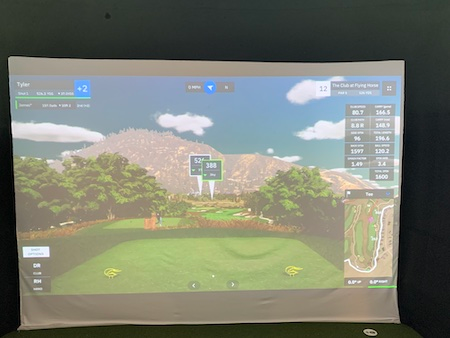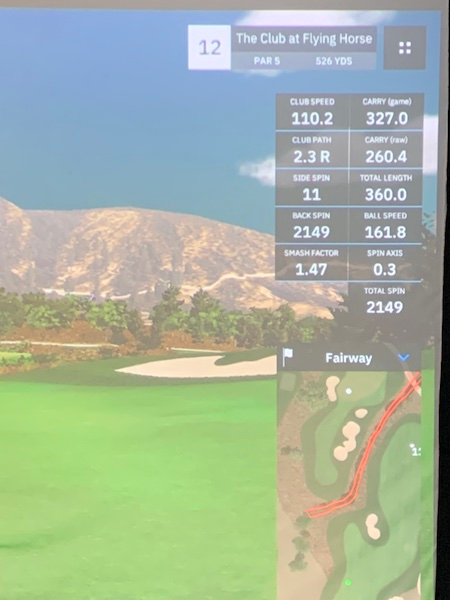Understanding the impact of elevation on the golf ball can make or break your game if you are traveling to an area with a higher elevation. In this article, we’ll discuss how altitude affects your distance, including a simple math formula you can use to adjust for the increased distance you are certain to see.
The Science Behind the Elevation Affect on a Golf Ball
The elevation of the golf course can have a significant impact on your game. At higher elevations, the air density is lower, which will cause the golf ball to travel farther and higher.
Simply put, there is less drag on the ball and less resistance – so it travels further at higher altitudes.
How much does elevation effect your golf ball distance? According to research and development engineers at Titleist – You can calculate the distance gain you will experience (compared to sea level) by multiplying the elevation (in feet) by .00116. (reference) – This will give you the percentage difference expected in distance.
For example, if you’re playing at an elevation of 5,000 feet, you can expect your golf ball to travel approximately 5.8% farther than at sea level (5000 x .00116 = 5.8).
If you play regularly and know your golf ball distance in your local area, it will just take a couple of steps to figure out the difference if you plan to travel or play a course at higher elevations.
Determine the elevation from your regular playing area. A simple Google search for “city, state elevation”. So, “St. Louis, MO elevation” for example. = 466 feet
Determine the elevation of the course you plan to play. Again, a simple Google search will give you what you need. So, “Colorado Springs elevation” for example – 5,994 feet
Find the difference: 5,994 – 466 = 5,528
Multiply the difference by .00116: 5,528*.00116 = 6.4%
Adjust your club selection accordingly!
Elevation Affect on Golf Ball Flight and Distance
I used the example above because I live in the St. Louis area and have traveled to Colorado Springs and played golf.
I did the math before going, and it was definitely necessary. I didn’t notice it as much from shots that were 100 yards and in – mainly because my skill level isn’t good enough to notice a difference of ~3 yards on a 50-yard shot.
But I absolutely noticed a difference when it came to club selection at say – 150 yards or more. I definitely needed to start taking less club starting at about 125 yards. And my driver – well, I’ve never hit the ball further – ever!
Related – Check out the Best Distance Golf Balls!
I noticed my ball would definitely go higher, and it seemed to “hang” in the air for quite a while. We played a hole that had an elevated tee, the ball almost looked like it got stuck in the air, it just floated.
Here is a picture from the real course, back in 2021.

Here is a snapshot on the same tee in the simulator on GSPro!

And an “after” tee shot. You can see my drive traveled 360 yards on the simulator. Everything beyond about 315 yards (my max distance local) is all elevation and downhill.

When I played the actual course back in 2021, I was definitely closer to that bunker and got a bit more distance out of my shot. Again, all of the credit goes to elevation and elevation on this one! Longest drive I’ve ever hit, but the thin air definitely played a huge part in this one.
Elevation Affect on Club Selection
If you are traveling somewhere with an elevation difference of about 4,000 feet or more, you should probably pay attention to it.
For every 1,000 feet in elevation you travel, you’ll get 1.16 yards more distance per 100 yards. So a normal 200 yard shot, you’ll get an extra 2.3 yards out of it. Really not noticeable for us mortals (everyday golfers).
But, once you start getting closer to 4,000 feet difference, you’ll notice! Your “normal” 150 yard club for example is now going to go nearly 160. Your 180 club is now going to travel 191.
At a difference of 4,000 elevation, a 280 yard drive is now going to travel just shy of 300 yards! So take that into account if you have water or a fairway ending.
FAQs
Conclusion
The elevation affect on golf ball is a crucial factor to consider when playing at higher elevation courses. By understanding the elevation affect on golf ball, you can make the necessary adjustments to your game to achieve optimal performance.
It is a simple math formula that can be applied. Simply multiply the additional altitude you are expecting by .00116 to find the percentage distance gain you should expect. Do the math, and adjust accordingly! It’s that simple.
Temperature can also affect your overall distance. I decided to do my own study on how the golf ball itself reacts to different temperatures. I also share details on the atmospheric temperature and its affects on golf ball distance.
Good luck on the golf course!
